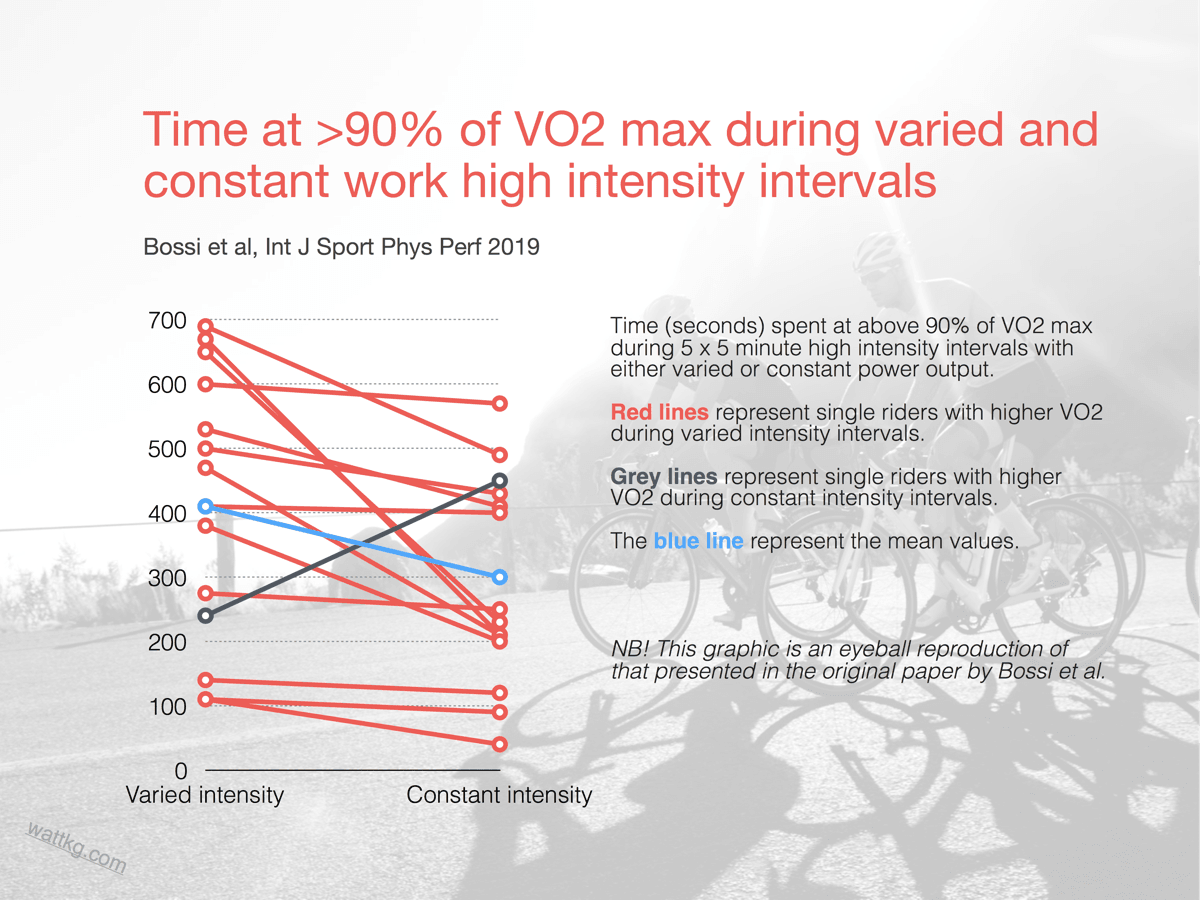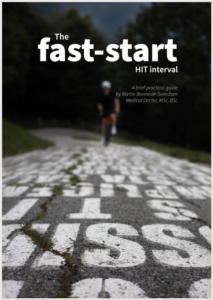If you are a keen cyclist you are probably looking for ways to optimize your intervals for greater training effect.
There is a handful of interesting studies showing compelling results with fast-start and varied intensity intervals.
Increased time at high VO2 with varied power output
Spending time at or above 90% of your VO2 max is often suggested as one of the hallmarks of efficient high intensity training (1-2).
As such, tweaking your intervals to maximize time spent above 90% of VO2 max might yield beneficial training effects.
A recent study by Bossi and colleagues examined the effect of varied power output on oxygen consumption during high intensity intervals (3).
Optimizing interval training through power output variation within the work intervals
In this study the authors compared traditional 5 x 5 minute intervals applying constant power output to 5 x 5 minute intervals using varied power output (3).
They then measured the accumulated time spent at VO2 values higher than 90% of VO2 max throughout the session. The scientists also tracked several other physiological parameters.
Who did they test?
14 well-trained male cyclists participated in the study. The subjects had a mean age of 24 years, VO2 max 69.2 ml/kg/min and power output at 4 mmol/L lactate (approx. anaerobic threshold) was 282W (3.77 W/kg).
How did they train?
At three separate days, participants performed:
- a battery of capacity tests
- a constant power HIIT session
- a varied power HIIT session.
The two HIIT sessions were performed in randomized order.
The constant power interval involved a traditional 5 x 5 minute interval at constant power output. Power was set to 84% of Maximal Aerobic Power (MAP). This correlates to a power that is a fair bit higher than power at 4 mmol/L (approx. AT), in other words your typical HIIT intensity.
The varied power interval consisted of three 30 second blocks at 100% of MAP interspersed by two 1-minute blocks and a final 1.5 minute at 77% of MAP:
- 0-0:30: 100% of MAP
- 0:30-1:30: 77% of MAP
- 1:30-2:00: 100% of MAP
- 2:00-3:00: 77% of MAP
- 3:00-3:30: 100% of MAP
- 3:30-5:00: 77% of MAP
100% of MAP correlates to a power well above that at 4 mmol/L lactate (approx. AT), whereas 77% of MAP was just slightly above the power obtained at approximate anaerobic threshold.
What did they find?
During the varied power interval, riders accumulated a mean of 410 seconds above 90% of VO2 max. This was significantly more than the 286 seconds accumulated during the constant power interval.
For the science geeks, p = 0.02 but somewhat overlapping 90% CL (312-508 vs 209-362).
All but one rider demonstrated more time at above 90% of VO2 max with the varied power intervals than with the constant power interval.

Importantly, the mean power output was the same for both intervals. Furthermore, riders reported the same rate of perceived exertion, nor was there any difference in training load as measured by heart rate (iTRIMP) between the two sessions.
These are certainly intriguing results – perhaps even more so when viewed in light of another recently published study in the same field.
Increased VO2 expenditure with fast start intervals
Rønnestad and colleagues published a resembling study on cross country skiers and biathletes (4).
In this experiment they examined the effect of a fast start approach.
This involved using a similar 5 x 5 minute interval protocol, with one session at constant speed and the other session with a faster start (90 seconds) and a somewhat slower final 3.5 minutes.
Here too, the authors report a higher peak VO2 and a higher mean VO2 throughout the fast start session compared to the constant speed session. They also observed a trend of longer time at above 90% of VO2 max (12.0 min) in the fast start interval compared to the constant speed interval (10.8 min). However, this latter result was not statistically significant.
They then further explored this finding in a second study, also involving cross-country skiers (5). Again, intervals executed with either a fast start or with varied speed yielded longer time above 90% of VO2 max during workouts when compared to traditional constant pace intervals. Interestingly, athletes did not perceive the fast-start or varied pace intervals as harder than the constant pace interval.
Varied intensity intervals is no new invention in the exercise science community. For instance, back in 2015 Zadow et al demonstrate increased time at above 85% of VO2 max with a 15 second all-out start during 3 minute intervals (6).
Furthermore, cyclists have been using so-called “under/over” intervals for ages.
Collectively, these present an interesting argument for considering the use of varied intensity during high intensity interval training.
How might it work, and do you actually get better?
The authors of the Bossi study discuss several mechanisms that may in part explain the increased time at high VO2 with varied intensity intervals.
These include:
- improved VO2 kinetics
- early recruitment of type II muscle fibres
- increased work due to increased ventilation
However, regardless of potential mechanisms you should note that the long term effects of this training has yet to be demonstrated.
For now we can say that there is a small handful of studies pointing towards increased time at high VO2 values when using fast start and varied power intervals.
From a theoretical point of view, you would expect this induce greater cardiovascular and possibly peripheral muscular adaptation. And as we all know, in sports even small gains may be worthwhile pursuing.
Whether or not the improved time at high VO2 translates into added long term performance enhancement remains for future research to investigate.
Until then, you can always experiment for yourself.
Food for thought.
Well-trained cyclists looking for alternative strategies to optimize training stimulus are advised to try the varied-intensity work intervals. … Whether performance adaptations will be superior to constant-intensity work intervals remains to be established…
– Bossi et al, Int Journ Sports Phys & Perf 2019
Get the fast-start interval workout in my free newsletter

When you subscribe to my newsletter you will receive the fast-start interval and other workout instructions, science reviews and discussions of best training practices. There is also occasional information about my paid services. I will take care not to clutter your inbox.
Best of luck with your fast-start intervals.
PS! Did you know that decreasing high intensity intervals are emerging as a promising option with some of the same VO2 characteristics as fast-start intervals?
References:
- Buchheim M and Lauren PB. High-intensity interval training, solutions to the programming puzzle: Part I: cardiopulmonary emphasis. Sports Medicine, 2013;43(5):313-338
- Midgley AW and Mc Naughton LR. Time at or near VO2 max during continuous and intermittent running. A review with special reference to considerations for the optimization of training protocols to elicit the longest time at or near VO2 max. The Journal of Sports Medicine and Physical Fitness, 2006;46(1):1-14
- Bossi AH et al. Optimizing interval training through power output variation within the work intervals. International Journal of Sports Physiology and Performance, 2019 (in press)
- Rønnestad et al. Increasing oxygen uptake in well-trained cross-country skiers during work intervals with a fast start. International Journal of Sports Physiology and Performance, 2019 (in press)
- Rønnestad BR et al. Increasing oxygen uptake in cross-country skiers by speed variation in work intervals. International Journal of Sports Physiology and Performance, 2021;17(3):384-390
- Zadow ET et al. Pacing, the missing piece of the puzzle to high-intensity interval training. International Journal of Sports Medicine, 2015;36:215-219
